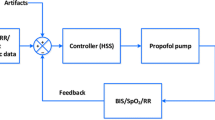Abstract
Closed loop target-control infusion systems using a Bispectral (BIS) signal as an input (TCI Loop) can automatically maintain intravenous anesthesia in a BIS range of 40–60 %. Our purpose was to assess to what extent such a system could decrease anesthesia workload in comparison to the use of a stand alone TCI system manually adjusted to fit the same BIS range of 40–60 % (TCI Manual). Patients scheduled for elective vascular or thoracic surgery were randomized to the TCI Loop or TCI Manual method for administering propofol and remifentanil during both induction and maintenance of general anesthesia. Assessment of workload was performed by an independent observer who quoted each time the physician looked at the BIS monitor. The number of propofol and remifentanil target modifications, the percentage of time of adequate anesthesia i.e. BIS in the range 40–60 and hemodynamic data were recorded. Eighteen patients per group were enrolled. Characteristics, duration of surgery and propofol-remifentanil consumption were similar between groups. However, the percentage of time in the BIS range 40–60 % was higher in the TCI Loop versus TCI Manual groups (94 % ± 12 vs. 74 % ± 19, p < 0.001). Mean arterial pressure was lower with TCI Manual (78 ± 6 vs. 88 ± 13 mmHg, p < 0.001). The number of times the anesthesiologist watched the controller or BIS monitor (p < 0.05) and the number of manual adjustments (p < 0.001) performed in each group was lower with TCI Loop group during induction and maintenance of anesthesia. An automated controller strikingly frees the anesthesiologist from manual intervention to adjust drug delivery.


Similar content being viewed by others
References
Santiago JV, Clemens AH, Clarke WL, Kipnis DM. Closed-loop and open-loop devices for blood glucose control in normal and diabetic subjects. Diabetes. 1979;28:71–84.
Mortier E, Struys M, De Smet T, Versichelen L, Rolly G. Closed-loop controlled administration of propofol using bispectral analysis. Anaesthesia. 1998;53:749–54.
Morley A, Derrick J, Mainland P, Lee BB, Short TG. Closed loop control of anaesthesia: an assessment of the bispectral index as the target of control. Anaesthesia. 2000;55:953–9.
Struys MM, De Smet T, Versichelen LF, Van De Velde S, Van den Broecke R, Mortier EP. Comparison of closed-loop controlled administration of propofol using bispectral index as the controlled variable versus “standard practice” controlled administration. Anesthesiology. 2001;95:6–17.
Liu N, Chazot T, Genty A, Landais A, Restoux A, McGee K, Laloe PA, Trillat B, Barvais L, Fischler M. Titration of propofol for anesthetic induction and maintenance guided by the bispectral index: closed-loop versus manual control: a prospective, randomized, multicenter study. Anesthesiology. 2006;104:686–95.
Absalom AR, Kenny GN. Closed-loop control of propofol anaesthesia using bispectral index: performance assessment in patients receiving computer-controlled propofol and manually controlled remifentanil infusions for minor surgery. Br J Anaesth. 2003;90:737–41.
Liu N, Chazot T, Trillat B, Pirracchio R, Law-Koune JD, Barvais L, Fischler M. Feasibility of closed-loop titration of propofol guided by the Bispectral Index for general anaesthesia induction: a prospective randomized study. Eur J Anaesthesiol. 2006;23:465–9.
Weinger MB, Reddy SB. Slagle JM: Multiple measures of anesthesia workload during teaching and nonteaching cases. Anesth Analg. 2004;98:1419–25. Table of contents.
Liu N, Chazot T, Hamada S, Landais A, Boichut N, Dussaussoy C, Trillat B, Beydon L, Samain E, Sessler DI, Fischler M. Closed-loop coadministration of propofol and remifentanil guided by bispectral index: a randomized multicenter study. Anesth Analg. 2011;112:546–57.
Schnider TW, Minto CF, Shafer SL, Gambus PL, Andresen C, Goodale DB, Youngs EJ. The influence of age on propofol pharmacodynamics. Anesthesiology. 1999;90:1502–16.
Minto CF, Schnider TW, Egan TD, Youngs E, Lemmens HJ, Gambus PL, Billard V, Hoke JF, Moore KH, Hermann DJ, Muir KT, Mandema JW, Shafer SL. Influence of age and gender on the pharmacokinetics and pharmacodynamics of remifentanil I. Model development. Anesthesiology. 1997;86:10–23.
Cantraine FR, Coussaert EJ. The first object oriented monitor for intravenous anesthesia. J Clin Monit Comput. 2000;16:3–10.
Jastremski M, Jastremski C, Shepherd M, Friedman V, Porembka D, Smith R, Gonzales E, Swedlow D, Belzberg H, Crass R, et al. A model for technology assessment as applied to closed loop infusion systems. Technology assessment task force of the society of critical care medicine. Crit Care Med. 1995;23:1745–55.
Beatty PC. Software safety considerations in the use of closed-loop, patient-connected control systems. Br J Anaesth. 1993;71:461–2.
Leedal JM, Smith AF. Methodological approaches to anaesthetists’ workload in the operating theatre. Br J Anaesth. 2005;94:702–9.
Agarwal J, Puri GD, Mathew PJ. Comparison of closed loop vs. manual administration of propofol using the bispectral index in cardiac surgery. Acta Anaesthesiol Scand. 2009;53:390–7.
Le Guen M, Liu N, Bourgeois E, Chazot T, Sessler DI, Rouby JJ, Fischler M: Automated sedation outperforms manual administration of propofol and remifentanil in critically ill patients with deep sedation: a randomized phase II trial. Intensive Care Med 2013;39(3):454–62.
Acknowledgments
This work has been sponsored by the CHU d’Angers. The authors have no financial relationship with this organisation. Ngai Liu and Thierry Chazot have patented in France the algorithm of the closed loop system used in this study (# BFF08P669, Institut National de la Propriété Industrielle). None of the authors has a personal financial interest in this research.
Conflict of interest
The authors declare they have no conflict of interest.
Author information
Authors and Affiliations
Corresponding author
Rights and permissions
About this article
Cite this article
Dussaussoy, C., Peres, M., Jaoul, V. et al. Automated titration of propofol and remifentanil decreases the anesthesiologist’s workload during vascular or thoracic surgery: a randomized prospective study. J Clin Monit Comput 28, 35–40 (2014). https://doi.org/10.1007/s10877-013-9453-6
Received:
Accepted:
Published:
Issue Date:
DOI: https://doi.org/10.1007/s10877-013-9453-6




